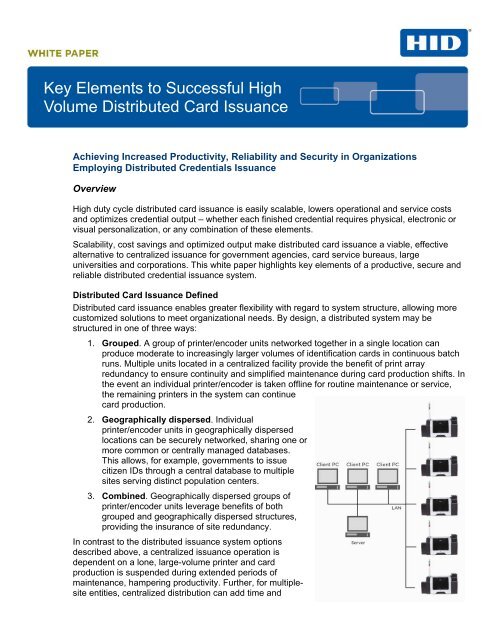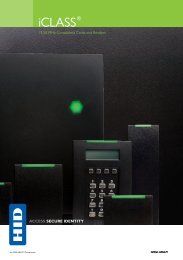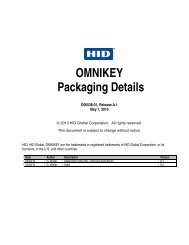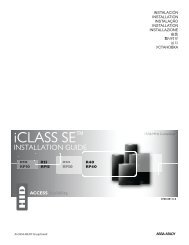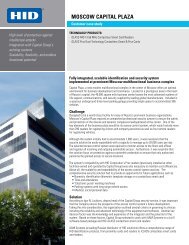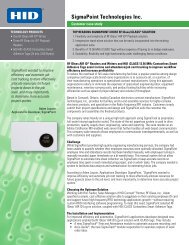FARGO HDP8500 Whitepaper - HID Global
FARGO HDP8500 Whitepaper - HID Global
FARGO HDP8500 Whitepaper - HID Global
You also want an ePaper? Increase the reach of your titles
YUMPU automatically turns print PDFs into web optimized ePapers that Google loves.
Key Elements to Successful High<br />
Volume Distributed Card Issuance<br />
Achieving Increased Productivity, Reliability and Security in Organizations<br />
Employing Distributed Credentials Issuance<br />
Overview<br />
High duty cycle distributed card issuance is easily scalable, lowers operational and service costs<br />
and optimizes credential output – whether each finished credential requires physical, electronic or<br />
visual personalization, or any combination of these elements.<br />
Scalability, cost savings and optimized output make distributed card issuance a viable, effective<br />
alternative to centralized issuance for government agencies, card service bureaus, large<br />
universities and corporations. This white paper highlights key elements of a productive, secure and<br />
reliable distributed credential issuance system.<br />
Distributed Card Issuance Defined<br />
Distributed card issuance enables greater flexibility with regard to system structure, allowing more<br />
customized solutions to meet organizational needs. By design, a distributed system may be<br />
structured in one of three ways:<br />
1. Grouped. A group of printer/encoder units networked together in a single location can<br />
produce moderate to increasingly larger volumes of identification cards in continuous batch<br />
runs. Multiple units located in a centralized facility provide the benefit of print array<br />
redundancy to ensure continuity and simplified maintenance during card production shifts. In<br />
the event an individual printer/encoder is taken offline for routine maintenance or service,<br />
the remaining printers in the system can continue<br />
card production.<br />
2. Geographically dispersed. Individual<br />
printer/encoder units in geographically dispersed<br />
locations can be securely networked, sharing one or<br />
more common or centrally managed databases.<br />
This allows, for example, governments to issue<br />
citizen IDs through a central database to multiple<br />
sites serving distinct population centers.<br />
3. Combined. Geographically dispersed groups of<br />
printer/encoder units leverage benefits of both<br />
grouped and geographically dispersed structures,<br />
providing the insurance of site redundancy.<br />
In contrast to the distributed issuance system options<br />
described above, a centralized issuance operation is<br />
dependent on a lone, large-volume printer and card<br />
production is suspended during extended periods of<br />
maintenance, hampering productivity. Further, for multiplesite<br />
entities, centralized distribution can add time and
expense to the credentials distribution process; either finished credentials must be packaged and<br />
sent to individuals, or card recipients are required the inconvenience of travel to a centralized<br />
location to obtain credentials.<br />
Key Printer Selection Criteria<br />
When networking printers into a high duty cycle distributed card issuance system, five important<br />
system criteria should be considered:<br />
1. Flexible print technology<br />
2. Printer system reliability<br />
3. System performance<br />
4. Operational convenience<br />
5. System scalability<br />
Flexible Print Technology<br />
When building a high duty cycle distributed card issuance system, it is important to specify printers<br />
that seamlessly integrate all relevant printing and encoding elements for the finished credentials.<br />
This will ensure maximum productivity, reliability and security.<br />
A broad spectrum of identification card materials and electronic components are in use today.<br />
Composite card materials are often used to lengthen card life, including PVC, PET, PETG, ABS,<br />
PC, and new configurations are likely on the horizon. Organizations should consider both current<br />
needs and future expectations for ID card composition. Accordingly, the selected printers should<br />
accommodate potential variations in card composition, material or thickness.<br />
Organizations must also consider the embedded electronic elements of the ID card – contact and<br />
contactless smart chips or combination technologies – to ensure encoding requirements are met.<br />
When it comes to print technology, retransfer or high definition<br />
printing (HDP®), offers distinct advantages over traditional direct-tocard<br />
printing. With HDP, a dye image is reverse-printed onto the<br />
underside of an adhesive film. The film is then transferred to the card<br />
surface, adding a durable layer of protection to the card and its<br />
components. The HDP process, wherein the printhead avoids direct<br />
contact with the card surface and any embedded electronics, is<br />
preferred for personalizing technology cards and mitigates the risk of<br />
damage to the electronics. Further, retransfer film conforms to ridges<br />
and indentations in the card surface, making it compatible with a wider array of card materials and<br />
thicknesses.<br />
2
Printer System Reliability<br />
Most card printers are not deployed into contaminant-free, climate-controlled environments. High<br />
duty cycle printing systems are generally at high risk for exposure to contaminants, pollutants and<br />
debris. These conditions can reduce the quality of finished cards, resulting in lower yields from<br />
batch card printing operations, and can cause premature wear on printer systems.<br />
In fact, internal printer environments are subject to high temperatures and exposure to<br />
unanticipated airborne debris during operation. In high-duty environments, continuous high heat<br />
inside a printer may disrupt card throughput and severely distort finished credentials, reducing print<br />
productivity and increasing the total cost of operation to organizations.<br />
For best results, choose printers that are ruggedized for continuous operation in tough<br />
environments. Following is a checklist of features that will help ensure the reliability of a high duty<br />
cycle printer unit:<br />
� Redundant card cleaning systems that routinely remove contaminants and debris from card<br />
surfaces during the personalization process.<br />
� Heavy-duty positive air flow and internal filtration systems that ensure consistent, stable<br />
performance.<br />
� Rugged metal construction, for durability and tamper-resistance.<br />
� Electronic temperature sensors that control print settings for optimal quality and<br />
performance.<br />
� Strong printer stepper motors that maintain card throughput during extended batch and shift<br />
printing.<br />
� Efficient card input gate systems to eliminate multiple card feed issues.<br />
� Enhanced material handling systems with high duty cycle metal components to prevent<br />
ribbon breaks and film errors.<br />
� Finely-tuned consumables cartridges with precision rollers and aluminum spindle shafts for<br />
consistent print image production.<br />
� Lifetime printhead warranty and a three-year warranty on all other components.<br />
3
System Performance<br />
The success of an organization’s card identification system is directly related to credentials<br />
issuance security, personalized card throughput, and the efficacy of the finished ID cards.<br />
Therefore, the mission of a card issuance program is to produce valid credentials, at a rate<br />
commensurate with demand and in a form that will perform reliably over the useful life of each<br />
issued card.<br />
Issuance Security<br />
The first level of security in a high duty cycle card issuance system limits operator access to its<br />
physical components. Mechanical locks should restrict access to printers, including card input and<br />
output hoppers and rejected cards. Further, physical locks should be placed on all access points to<br />
protect ribbon and film consumables.<br />
Electronic security is also critical. Ideally, operator access to each printer is controlled via personal<br />
identification numbers (PIN). Print job data packets should meet or exceed advanced encryption<br />
standard, such as (AES) 256 bit data encryption, to ensure system privacy, integrity and<br />
authentication to the final issuance endpoint.<br />
An often overlooked area that can significantly reduce the risk of identity theft is to ensure automatic<br />
elimination of personal data on used ribbon panels.<br />
Card Throughput<br />
With sophisticated microprocessors at their cores, contemporary card printing and encoding<br />
systems are capable of performing multiple operations simultaneously, yielding card throughput<br />
efficiency and speed. Each individual station can work independently, yet simultaneously with other<br />
printer/encoder units, to seamlessly print visual personalization, encode data via one or multiple<br />
technologies – magnetic stripe, smart card, or proximity – and finally to apply layers of secure,<br />
protective lamination.<br />
Multiple print mode settings introduce varied card throughput rates based upon the organization’s<br />
card design. Higher throughput card personalization speed for cards requiring graphics-only<br />
personalization may be alternated with higher definition, high resolution image quality<br />
personalization requirements and the flexibility to print at more traditional card throughput speeds.<br />
Another feature that can enhance throughput is a dual input hopper. When one card type is being<br />
issued, the printer will pull blank cards from the full hopper, while the second hopper is being<br />
refilled, enabling continuous operation. If multiple card types are being issued, each printer can<br />
automatically select between two card blanks to produce the correct credentials for each card<br />
request, eliminating the need for manual hopper changes during multi-card-type production.<br />
Credential Efficacy<br />
Ultimately, the efficacy of any identification system comes down to how effectively the issued<br />
credentials meet the demands of use over the desired life of the card.<br />
This is another area in which HDP, or retransfer, print technology provides distinct advantages.<br />
HDP film protects printed images, creating more durable credentials and providing clear visual<br />
evidence if tampering is attempted.<br />
For additional security and durability, organizations may choose from specialty retransfer films,<br />
which may incorporate visual security elements to deter counterfeiting – such as custom holograms,<br />
fluorescing images or microtext – and provide improved card abrasion resistance for long-life use.<br />
4
To maximize security and durability, and significantly extend card life, additional in-line card<br />
lamination may be applied over the retransfer film that can further extend life to the card and<br />
varying levels of overt or covert visual security elements.<br />
Operational Convenience<br />
Even the heartiest machines require routine maintenance – from reloading card hoppers and<br />
changing ribbon cartridges, to dislodging the occasional card that has jammed. Advanced printers<br />
are engineered to minimize operator time and effort required for maintenance, thus maximizing<br />
uptime and system throughput.<br />
When repair is necessary, the more quickly a technician can identify the problem and implement a<br />
solution, the more quickly that printer gets back online. Often, diagnosis requires technicians to<br />
physically examine individual machines to assure each is operating properly. However, today’s<br />
more advanced printers are equipped with automated diagnostic systems that can alert operators<br />
as issues arise, via andon lights or graphic displays; touch screen interfaces and Help screens<br />
enable easier problem identification and resolution.<br />
The objective is to seek solutions that lower the total cost of operation while reducing downtime.<br />
Look for the following features to help ensure operational ease:<br />
� Visible card feed mechanism: Enables unobstructed operator access to cards in print,<br />
programming or lamination stages to quickly identify and remove card jams.<br />
� Card personalization reject bin: Automatically segregates mis-programmed cards from<br />
completed cards.<br />
� Dual high-capacity input and output hoppers: Enables continuous card personalization runs,<br />
while reducing frequency of operator intervention for loading and unloading.<br />
� Touch screen display: Provides intuitive graphical interface for system feedback and<br />
operator input.<br />
� In-line card flattening mechanism: Minimizes and corrects post-personalized warpage due to<br />
variation in card material construction and improves throughput yield.<br />
� Sealed print mechanism: Mitigates risk of card contamination during print process.<br />
� Dual-cleaning stations: Pre and post personalization, to ensure optimal quality of finished<br />
cards.<br />
5
System Scalability<br />
The modular architecture of distributed card issuance systems enables greater versatility and<br />
flexibility. Field upgradeable modules may be easily added to meet current or future specialized<br />
credential needs, such as:<br />
� ISO magnetic encoding<br />
� Large capacity card input hoppers<br />
� Dual-side printing<br />
� Contact or contactless card encoding<br />
� ISO card flattening<br />
� Single- or dual-sided lamination<br />
� Laser engraving<br />
The volume of card output is also easily scalable with distributed card issuance systems. When<br />
building an initial system, an organization can specify a network of printers that precisely meets<br />
current needs with regard to output. As the organization grows and card issuance needs increase,<br />
the network can expand in defined increments to meet demand simply by connecting additional<br />
printers. Inversely, if credentials issuance needs decrease over time, output can be trimmed by<br />
reducing the number of printers in the network.<br />
6
About the author<br />
As the world leader in distributed credentials issuance, <strong>HID</strong> <strong>Global</strong> pioneered the High Definition<br />
Printing (HDP®) – or retransfer printing – process, and continues to lead the industry in applying<br />
HDP to produce more secure, reliable identification cards. <strong>HID</strong> <strong>Global</strong>’s secure issuance solutions<br />
provide the most comprehensive array of printers for custom card personalization, from creating<br />
high-quality color photo IDs to encoding smart cards. With the industry’s first fully modular, scalable<br />
and future-proof Direct-to-Card (DTC) and High Definition (HDP) printer portfolio, along with its<br />
complete line of visual security products and accessories, <strong>HID</strong>’s secure issuance solutions meet the<br />
card customization needs of small businesses, global enterprise organizations and government<br />
agencies worldwide. <strong>HID</strong> <strong>Global</strong> also offers complete card read/write interoperability for all Genuine<br />
<strong>HID</strong> and other technology cards.<br />
hidglobal.com<br />
© 2011 <strong>HID</strong> <strong>Global</strong>. All rights reserved. HDP, <strong>HID</strong>, the <strong>HID</strong> logo, and Genuine <strong>HID</strong> are trademarks or registered trademarks of <strong>HID</strong> <strong>Global</strong> in the U.S. and/or other countries. All<br />
other trademarks, service marks, and product or service names are trademarks or registered trademarks of their respective owners.<br />
20111031-hid-DistributedIssuance-wp-en<br />
7


